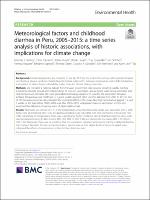Meteorological factors and childhood diarrhea in Peru, 2005–2015: a time series analysis of historic associations, with implications for climate change
Metadata
Show full item recordAuthor(s)
Date
2021-02-26Subject
Cambio Climático - Hidrometeorología - Efectos del Clima - Temperatura - Mitigación de la contaminación - Abastecimiento de Agua - Agua para consumo - Saneamiento y Salud públicaCollections
- Artículo científico [176]
Related Resource(s)
https://ehjournal.biomedcentral.com/articles/10.1186/s12940-021-00703-4Abstract
Background: Global temperatures are projected to rise by ≥2 °C by the end of the century, with expected impacts on infectious disease incidence. Establishing the historic relationship between temperature and childhood diarrhea is important to inform future vulnerability under projected climate change scenarios.
Methods: We compiled a national dataset from Peruvian government data sources, including weekly diarrhea surveillance records, annual administered doses of rotavirus vaccination, annual piped water access estimates, and daily temperature estimates. We used generalized estimating equations to quantify the association between ambient temperature and childhood (< 5 years) weekly reported clinic visits for diarrhea from 2005 to 2015 in 194 of 195 Peruvian provinces. We estimated the combined effect of the mean daily high temperature lagged 1, 2, and 3 weeks, in the eras before (2005–2009) and after (2010–2015) widespread rotavirus vaccination in Peru and examined the influence of varying levels of piped water access.
Results: Nationally, an increase of 1 °C in the temperature across the three prior weeks was associated with a 3.8% higher rate of childhood clinic visits for diarrhea [incidence rate ratio (IRR): 1.04, 95% confidence interval (CI): 1.03– 1.04]. Controlling for temperature, there was a significantly higher incidence rate of childhood diarrhea clinic visits during moderate/strong El Niño events (IRR: 1.03, 95% CI: 1.01–1.04) and during the dry season (IRR: 1.01, 95% CI:
1.00–1.03). Nationally, there was no evidence that the association between temperature and the childhood diarrhea rate changed between the pre- and post-rotavirus vaccine eras, or that higher levels of access to piped water mitigated the effects of temperature on the childhood diarrhea rate.
Conclusions: Higher temperatures and intensifying El Niño events that may result from climate change could increase clinic visits for childhood diarrhea in Peru. Findings underscore the importance of considering climate in assessments of childhood diarrhea in Peru and globally, and can inform regional vulnerability assessments and mitigation planning efforts.
The following license files are associated with this item:








